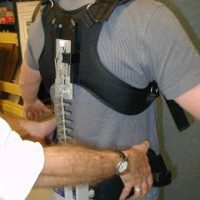Insights
Clinical Lumbar Motion Monitor
This is a new medical device that I’ve just read about, a clinical Lumbar Motion Monitor (cLMM). It’s a new device to help physicians treat patients with back disorders. The cLMM assesses the lower back, in motion, to accurately determine the extent and nature of impairment, and also to measure the current risk of re-injury. The device was developed by The Ohio State University’s Spine Research Institute, and it is part of a pilot program with the Ohio Bureau of Workers’ Compensation. I also heard about the cLMM at an advanced workers’ compensation seminar (Continuing Legal Education) last month at the Hollywood Casino in Columbus (great place for a CLE!).
 The cLMM is a wearable device, and while wearing it the patient interacts with a computer screen to complete a series of non-forced exertions. The patient’s movements are tracked on a computer, and this provides a comprehensive view of their range of motion. I haven’t seen the device, but I heard it described as something like what you might see with a gaming console (on Wii, or something like that – I’m guessing it’s probably not as much fun!).
The cLMM is a wearable device, and while wearing it the patient interacts with a computer screen to complete a series of non-forced exertions. The patient’s movements are tracked on a computer, and this provides a comprehensive view of their range of motion. I haven’t seen the device, but I heard it described as something like what you might see with a gaming console (on Wii, or something like that – I’m guessing it’s probably not as much fun!).
I’d be interested to know if the Bureau of Workers’ Compensation may eventually try to use the cLMM device as a means of evaluating permanent partial impairment. Those evaluations are very important in a workers’ compensation claim. I think all parties to a claim would benefit from more accurate impairment evaluations. I am aware that physicians have more conventional devices to measure a person’s range of motion – with either an inclinometer or goniometer – but even with those devices, I’ve seen significantly divergent findings from different physicians examining the same person.
I’m not aware of whether the Bureau of Workers’ Compensation is interested in the cLMM in so far as permanent partial impairment evaluations are concerned, but it seems like something worth considering.
Thanks for reading!
